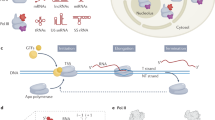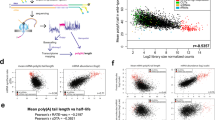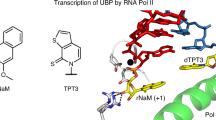Abstract
Ribonuclease (RNase) E is an extensively studied enzyme from Escherichia coli whose site-specific endoribonuclease activity on single-stranded RNA has a central role in the processing of ribosomal RNA, the degradation of messenger RNA and the control of replication of ColE1-type plasmids (for recent reviews, see 1–3). Here we report a previously undetected activity of RNase E: the ability to shorten 3′ poly(A)- and poly(U)-homopolymer tails on RNA molecules. This activity, which leaves a 6-nucleotide adenylate or a 1-nucleotide uridylate remnant on primary transcripts, resides in the amino-terminal region of RNase E and does not require other protein cofactors. Addition of a 3′-terminal phosphate group prevents both removal of the poly(A) tail and endonucleolytic cleavage within primary transcripts, but has no effect on the cleavage of transcripts with tails that have already been truncated. The ability of RNase E to shorten poly(A) tails, together with the effect of tail length on endonucleolytic cleavage within primary transcripts, suggests a mechanism by which RNase E may exercise overall control over RNA decay.
This is a preview of subscription content, access via your institution
Access options
Subscribe to this journal
Receive 51 print issues and online access
$199.00 per year
only $3.90 per issue
Buy this article
- Purchase on Springer Link
- Instant access to full article PDF
Prices may be subject to local taxes which are calculated during checkout



Similar content being viewed by others
References
Cohen, S. N. & McDowall, K. J. RNase E: still a wonderfully mysterious enzyme. Mol. Microbiol. 23, 1099–1106 (1996).
Ehretsmann, C. P., Carpousis, A. J. & Krisch, H. M. mRNA degradation in procaryotes. FASEB J. 6, 3186–3192 (1992).
Melefors, O., Lundberg, U. & von Gabain, A. in Control of Messenger RNA Stability (eds Belasco, J. & Brawerman, G.) 53–70 (Academic, San Diego, (1993)).
Tomcsanyi, T. & Apirion, D. Processing enzyme ribonuclease E specifically cleaves RNA I: an inhibitor of primer formation in plasmid DNA synthesis. J. Mol. Biol. 185, 713–720 (1985).
Lin-Chao, S. & Cohen, S. N. The rate of processing and degradation of antisense RNAI regulates the replication of ColE-1 type plasmids in vivo. Cell 65, 1233–1242 (1991).
Littauer, U. Z. & Soreq, H. Polynucleotide phosphorylase. The Enzymes XV, 517–553 (1982).
Singer, M. F. & Tolbert, G. Purification and properties of a potassium-activated phosphodiesterase (RNase II) from Escherichia coli. Biochemistry 4, 1319–1330 (1965).
Nossal, N. G. & Singer, M. F. The processive degradation of individual polyribonucleotide chains. J. Biol. Chem. 243, 913–922 (1968).
Klee, C. B. & Singer, M. F. The processive degradation of individual polyribonucleotide chains. J. Biol. Chem. 243, 923–927 (1968).
McDowall, K. J. & Cohen, S. N. The N-terminal domain of the rne gene product has RNase E activity and is non-overlapping with the arginine-rich RNA-bindign motif. J. Mol. Biol. 255, 349–355 (1996).
Kido, M., Yamanaka, K., Mitani, T., Niki, H., Ogura, T. & Hiraga, S. RNase E polypeptides lacking a carboxyl-terminal half suppress a mukB mutation in Escherichia coli. J. Bacteriol. 178, 3917–3925 (1996).
Helmer-Citterich, M., Anceschi, M. M., Banner, D. W. & Cesareni, G. Control of ColE1 replication: low affinity specific binding of Rop (Rom) to RNAI and RNAII. EMBO J. 7, 557–566 (1988).
Xu, F. & Cohen, S. N. RNA degradation in Escherichia coli regulated by 3′ adenylation and 5′ phosphorylation. Nature 374, 180–183 (1995).
Xu, F., Lin-Chao, S. & Cohen, S. N. The Escherichia coli pcnB gene promotes adenylylation of antisense RNAI of ColE1-type plasmids in vivo and degradation of RNAI decay intermediates. Proc. Natl Acad. Sci. USA 90, 6756–6760 (1993).
Claverie-Martin, F., Wang, M. & Cohen, S. N. Ard-1 cDNA from human cells encodes a site-specific single strand endoribonuclease that functionally resembles Escherichia coli RNase E. J. Biol. Chem. 272, 13823–13828 (1997).
Kaberdin, V.. R., Chao, Y.-H. & Lin-Chao, S. RNase E cleaves at multiple sites in bubble region of RNAI stem-loops yielding products and dissociate differentially from the enzyme. J. Biol. Chem. 271, 13103–13109 (1996).
Caponigro, G. & Parker, R. Mechanisms and control of mRNA turnover in Saccharomyces cerevisiae. Microbiol. Rev. 60, 233–249 ((1996)).
Cohen, S. N. Surprises at the 3′ end of prokaryotic RNA. Cell 80, 829–832 (1995).
Sarkar, N. Polyadenylation of mRNA in bacteria. Microbiology 142, 3125–3133 (1996).
Hajnsdorf, E., Braun, F., Haugel-Nielsen, J. & Regnier, P. Polyadenylation destabilizes the rpsO mRNA of Escherichia coli. Proc. Natl Acad. Sci. USA 92, 3973–3977 (1995).
Coburn, G. A. & Mackie, G. A. Overexpression, purification, and properties of Escherichia coli ribonuclease II. J. Biol. Chem. 271, 1048–1053 (1996).
Py, B., Higgins, C. F., Krisch, H. M. & Carpousis, A. J. ADEAD-box RNA helicase in the Escherichia coli RNA degradosome. Nature 381, 169–172 (1996).
Carpousis, A. J., Van Houwe, G., Ehretsmann, G. & Krisch, H. M. Copurification of E. coli RNase E and PNPase: evidence for a specific association between two enzymes important in RNA processing and degradation. Cell 76, 889–900 (1994).
Miczak, A., Kaberdin, V. R., Wei, C. L. & Lin-Chao, S. Proteins associated with RNase E in a multicomponent ribonucleolytic complex. Proc. Natl Acad. Sci. USA 93, 3865–3869 (1996).
Py, B., Causton, H., Mudd, E. A. & Higgins, C. F. Aprotein complex mediating mRNA degradation in Escherichia coli. Mol. Microbiol. 14, 717–799 (1994).
Razzell, W. E. & Khorana, H. G. Studies on polynucleotides. III. Enzymatic degradation. Substrate specificity and properties of snake venom phosphodiesterase. J. Biol. Chem. 234, 2105–2113 (1959).
Jacobson, A. Poly(A) metabolism and translation: The closed-loop model.in Cold Spring Harbor Monogr. Ser. 30, 451–480 (1996).
Hochuli, E., Dobeli, H. & Schacher, A. New metal chelate adsorbent selective for proteins and peptides containing neighboring histidine residues. J. Chromatogr. 411, 177–184 (1987).
Acknowledgements
These studies were supported by a grant for mthe US NIH. We thank Y. Feng for his-tagged PAP I constructs, and J. Belasco, R. Lehman and C. Higgins for comments on this manuscript.
Author information
Authors and Affiliations
Corresponding author
Rights and permissions
About this article
Cite this article
Huang, H., Liao, J. & Cohen, S. Poly(A)- and poly(U)-specific RNA 3′ tail shortening by E. coli ribonuclease E. Nature 391, 99–102 (1998). https://doi.org/10.1038/34219
Received:
Accepted:
Published:
Issue Date:
DOI: https://doi.org/10.1038/34219
This article is cited by
-
Relaxed Cleavage Specificity of Hyperactive Variants of Escherichia coli RNase E on RNA I
Journal of Microbiology (2023)
-
RNase E: at the interface of bacterial RNA processing and decay
Nature Reviews Microbiology (2013)
-
Nipp1
AfCS-Nature Molecule Pages (2007)
-
Ribonuclease E is a 5′-end-dependent endonuclease
Nature (1998)
Comments
By submitting a comment you agree to abide by our Terms and Community Guidelines. If you find something abusive or that does not comply with our terms or guidelines please flag it as inappropriate.



